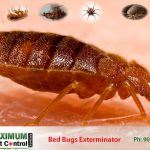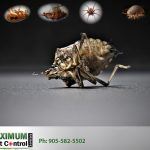
Getting Alert and Acquainted with Bed Bugs Symptoms
Usually, people are unaware of the symptoms of bedbugs. People cannot immediately detect if there are already bedbugs infestation inside their home and personal belongings where their pets roam around.
Home pets are related to the infestation of bedbugs because they are the unconscious agent that transmits bedbugs from outside to the many parts inside the house. The only time that most people detect that there is indeed symptoms of bed bugs inside their home is until they complain about excessive itching and insect bite marks. To make certain that your house is indeed experiencing bedbugs symptoms, check the following:
1- Look for excrement or fecal stains; shed skins of bedbugs’ nymphs and egg cases in cracks, holes and crevices near your bed or in the bed itself. The bed springs, headboard, mattresses, wallpapers and the clothing inside the dresser must be checked to see for reddish brown excrement stains. The living room, furniture, appliances and every other areas of the house where your house pets usually dwell in should also be checked.
2- A severe bedbug infested home would experience a sweet, offensive and musty scent. This is the odor that is excreted by the bedbugs through their scent glands.
Facts about Bedbugs
Bites of bedbugs are frequently mistaken to dust mites and mosquitoes. So to get more acquainted with their symptoms, you can rely on below:
- Bedbugs are flat and oval in shape. Therefore, they can extremely hide in thin cracks of wall that is the main reason why their site for breeding and hiding is indeed hard to find.
- Bedbugs are said to be nocturnal insects which means they are active during night time, most particularly an hour prior to the break of dawn but if they hungry they operate Anytime.
- Bedbugs feed themselves by using their 2 elongated beaks and biting human skin to suck in blood.
- One of their beaks injects saliva which contains anesthetic that is why you may not feel the pain while their beak pierced into the skin and anticoagulant to save blood clotting.
- The other beak of the bedbug is used to suck in blood.
- An adult bedbug can thrive up to 13 months or longer without sucking blood and just staying in their breeding or hiding place until a host comes who can satiate their blood need.
- Female bedbugs can lay up to 300 or more eggs and after 10 days, bedbugs’ nymphs will come out from these eggs ready for a blood meal.
- Bedbugs are also called hitchhikers because of their ability in traveling long distances through riding on luggage, clothing and suitcases include public daily transportation taxi’s and buses.
If you have detected that a certain part or object in your house is infested with bedbugs, say for example, the bedroom wallpapers then immediately tear it off. For objects which seem to have container-shape like the nightstand, examine its inside and out.
You should always remember that bedbugs are silent hitchhikers. They can crawl up easily anywhere anytime and hide themselves in any discrete part of the house and wait. So be meticulous and keep an eye to your belongings and objects at home every now and then to check on to these pestering blood sucking bedbugs. Searching for a Local Residential, Commercial and Industrial Pest Control Services, you are covered from Bedbugs, Insects, Rodents and Wildlife.
Call Maximum Today at (289) 396-5426 or (905) 582-5502.



